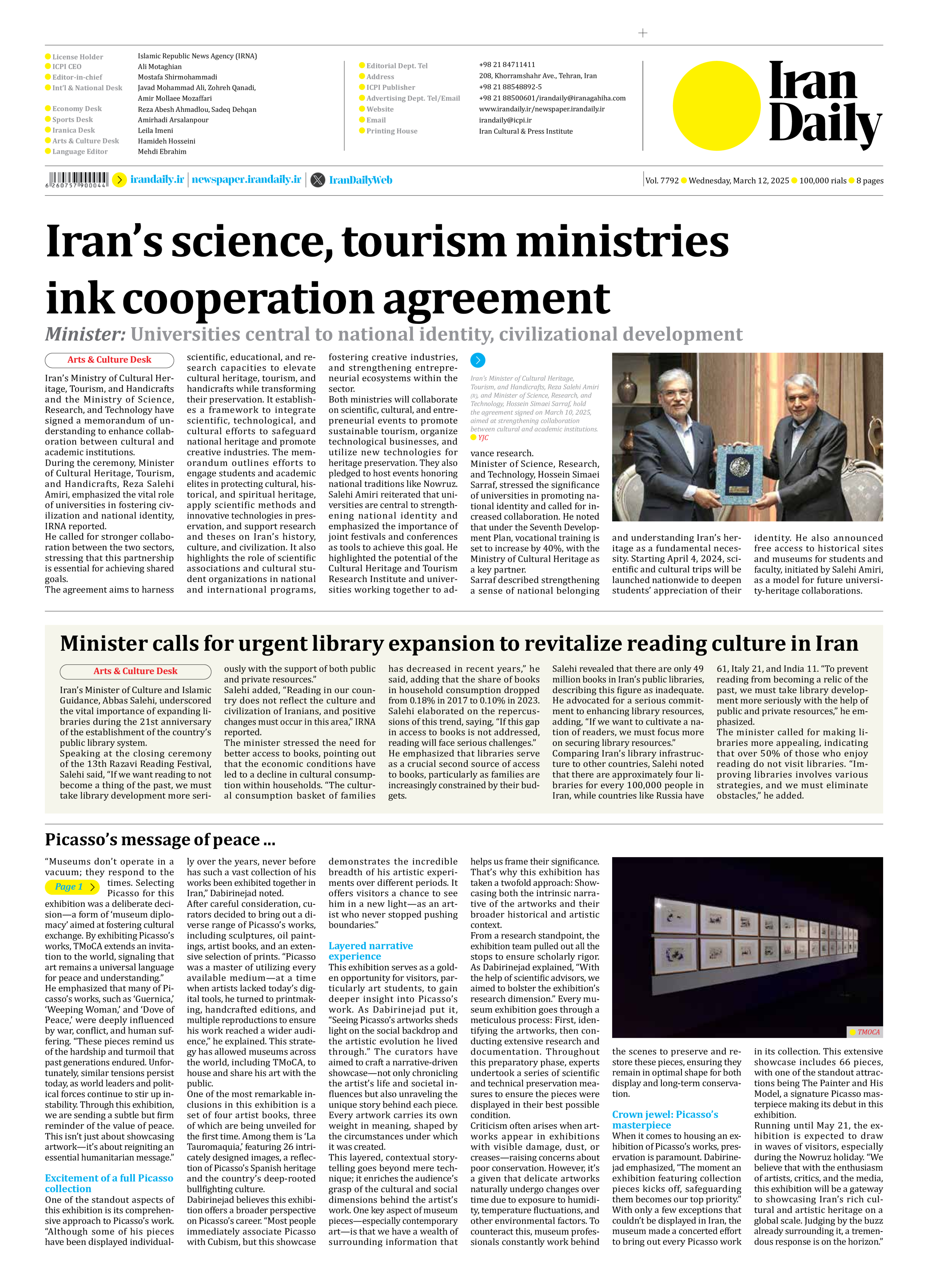
Picasso’s message of peace ...
Page 1
“Museums don’t operate in a vacuum; they respond to the times. Selecting Picasso for this exhibition was a deliberate decision—a form of ‘museum diplomacy’ aimed at fostering cultural exchange. By exhibiting Picasso’s works, TMoCA extends an invitation to the world, signaling that art remains a universal language for peace and understanding.”
He emphasized that many of Picasso’s works, such as ‘Guernica,’ ‘Weeping Woman,’ and ‘Dove of Peace,’ were deeply influenced by war, conflict, and human suffering. “These pieces remind us of the hardship and turmoil that past generations endured. Unfortunately, similar tensions persist today, as world leaders and political forces continue to stir up instability. Through this exhibition, we are sending a subtle but firm reminder of the value of peace. This isn’t just about showcasing artwork—it’s about reigniting an essential humanitarian message.”
Excitement of a full Picasso collection
One of the standout aspects of this exhibition is its comprehensive approach to Picasso’s work. “Although some of his pieces have been displayed individually over the years, never before has such a vast collection of his works been exhibited together in Iran,” Dabirinejad noted.
After careful consideration, curators decided to bring out a diverse range of Picasso’s works, including sculptures, oil paintings, artist books, and an extensive selection of prints. “Picasso was a master of utilizing every available medium—at a time when artists lacked today’s digital tools, he turned to printmaking, handcrafted editions, and multiple reproductions to ensure his work reached a wider audience,” he explained. This strategy has allowed museums across the world, including TMoCA, to house and share his art with the public.
One of the most remarkable inclusions in this exhibition is a set of four artist books, three of which are being unveiled for the first time. Among them is ‘La Tauromaquia,’ featuring 26 intricately designed images, a reflection of Picasso’s Spanish heritage and the country’s deep-rooted bullfighting culture.
Dabirinejad believes this exhibition offers a broader perspective on Picasso’s career. “Most people immediately associate Picasso with Cubism, but this showcase demonstrates the incredible breadth of his artistic experiments over different periods. It offers visitors a chance to see him in a new light—as an artist who never stopped pushing boundaries.”
Layered narrative experience
This exhibition serves as a golden opportunity for visitors, particularly art students, to gain deeper insight into Picasso’s work. As Dabirinejad put it, “Seeing Picasso’s artworks sheds light on the social backdrop and the artistic evolution he lived through.” The curators have aimed to craft a narrative-driven showcase—not only chronicling the artist’s life and societal influences but also unraveling the unique story behind each piece. Every artwork carries its own weight in meaning, shaped by the circumstances under which it was created.
This layered, contextual storytelling goes beyond mere technique; it enriches the audience’s grasp of the cultural and social dimensions behind the artist’s work. One key aspect of museum pieces—especially contemporary art—is that we have a wealth of surrounding information that helps us frame their significance. That’s why this exhibition has taken a twofold approach: Showcasing both the intrinsic narrative of the artworks and their broader historical and artistic context.
From a research standpoint, the exhibition team pulled out all the stops to ensure scholarly rigor. As Dabirinejad explained, “With the help of scientific advisors, we aimed to bolster the exhibition’s research dimension.” Every museum exhibition goes through a meticulous process: First, identifying the artworks, then conducting extensive research and documentation. Throughout this preparatory phase, experts undertook a series of scientific and technical preservation measures to ensure the pieces were displayed in their best possible condition.
Criticism often arises when artworks appear in exhibitions with visible damage, dust, or creases—raising concerns about poor conservation. However, it’s a given that delicate artworks naturally undergo changes over time due to exposure to humidity, temperature fluctuations, and other environmental factors. To counteract this, museum professionals constantly work behind the scenes to preserve and restore these pieces, ensuring they remain in optimal shape for both display and long-term conservation.
Crown jewel: Picasso’s masterpiece
When it comes to housing an exhibition of Picasso’s works, preservation is paramount. Dabirinejad emphasized, “The moment an exhibition featuring collection pieces kicks off, safeguarding them becomes our top priority.” With only a few exceptions that couldn’t be displayed in Iran, the museum made a concerted effort to bring out every Picasso work in its collection. This extensive showcase includes 66 pieces, with one of the standout attractions being The Painter and His Model, a signature Picasso masterpiece making its debut in this exhibition.
Running until May 21, the exhibition is expected to draw in waves of visitors, especially during the Nowruz holiday. “We believe that with the enthusiasm of artists, critics, and the media, this exhibition will be a gateway to showcasing Iran’s rich cultural and artistic heritage on a global scale. Judging by the buzz already surrounding it, a tremendous response is on the horizon.”







